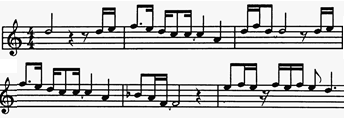1. Composition of the themes
Composing a song is not depending on a chronologic order, each artist's work is personal and depends on his own preferences and musical experience.
The musical themes, lyrics, chord progression, le-rythme or a specific atmosphere could also be a guide in song creation.
In our example called "Tu étais là" (Stéphane Ellia / Yves Feger) the musical themes (melodies) were created at first.
Here below are useful advices:
a. The simplicity
Simplicity has been common to all of the great "hits" during decades. In fact, song writing is a popular art, and a great tune must be heard and memorized by everyone.
b. The vocal writing
The human voice is probably the most difficult instrument to handle, because , unlike most of the music instruments, the tuning is not based on a clef or a neck but on the ear only.
In order to make a vocal performance easier, let's look at the following rules:
- Melodic intervals must be as short as possible (2nds, 3rds, 4ths, 5ths, 6ths or 8ves).
- Avoid difficult intervals (7ths, 9ths, 10ths, 11ths etc..), augmented and diminished intervals, and long chromaticism (successive semi-tones).
- The melodic range must fit the performer's voice. We also avoid staying too long time in the extreme registers (low or high registers), which are very difficult to handle.
- Breathings must be frequent, allowing singers to feel confortable. They will be situated at some specific moments, in order to fit the lyrics structure.
- The melodic curve should be soft and follow a specific direction, in order to bring contrast to the instruments.
c. The number of themes
When many themes are present, we can obtain a blurred feeling, and the auditor can get confused. On the contrary, 1 theme only is risky because it will be repeated too many times becoming bothering by this way.
d. Tension, climax and relax steps
A melody includes 3 phases : tension, climax and relax. These steps bring life to the music, and we avoid monotony.
2. Analysis of the themes
Our example includes 3 main themes (verse, bridge and chorus)
a. The 1st theme (verse) in D major is 8 bar long, but really has 4 bar only, repeated 2 times:

Notes
- The "range" (distance between the lowest and the highest note) is: 1 octave.
- The intervals between 2 neighbour notes are not larger than a major 6th.
- In this song, the range A2 / A3 is good for the male lead voice.
- Two breathings are placed on bars 3 and 7 (3rd beats).
- The tension (bars 1 to 6), climax (bars 6) and relax steps (bars 6 to 8) are situated at the good places.
- The intervals remain simple and singable.
b. The 2nd theme (bridge) leading to the A major key, is 7 bars long:

Notes
- The range is around an interval of a major 6th (G3 / E4).
- The maximum distance between 2 neighbour notes is a perfect 4th only.
- The register moves to a perfect 5th higher.
- Two breathings are found on bars 3 and 7.
- The two climax notes ( E4 ) are found in bars 2 and 5.
c. the 3rd theme (chorus) is also in D major, with a modal colour brought by the Bb note (minor 6th degree):

Notes
- The range is an 8ve.
- The interval between 2 neighbour tones increases up to a major 7th.
- The register is higher and becomes more tensed (F4).
- Three breathings are necessary (bars 1,3 and 5)
- Three breathings are necessary (mes. 1,3 et 5)